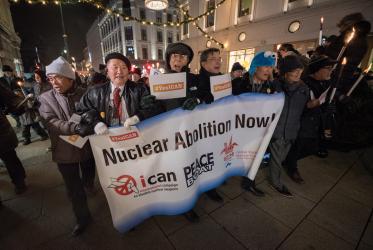As we get off the train in Hiroshima, we are welcomed by sign boards with origami cranes. Immediately, our thoughts are fixed on the girl Sadako Sasaki, who was two years old when the bomb hit Hiroshima.
She and her family were far enough to stay alive, even though their house was all blown up. They were grateful and happy to survive; but nine years later, Sadako became ill. She turned out to have leukaemia and heard she had only three months to live, a year at the most.
In the days on which she realised she wouldn’t have much time to live anymore, she remembered how her mother used to tell about paper cranes. “If you fold a thousand of them, your wish will be fulfilled”. From that moment, Sadako had a mission and folded over a thousand cranes.
She didn’t recover herself, but wished for a world in peace, in which no more nuclear weaponry would be used. After her death, her friends from school carried on her wish by folding even more cranes.
At this day, Hiroshima has a children’s memorial, with the statue of a girl sending cranes into the world. And surrounding Hiroshima’s commemoration of seventy years since the nuclear bombardment, we see a great many children, adults and senior citizens who, as a sign of hope, have brought cranes along.
For the World Council of Churches, I am part of a delegation that attends the commemorations in Hiroshima and Nagasaki. One of the last chances to talk with survivors, hibakusha as they are called in Japanese. People who were not struck dead by one of the bombs themselves, but were confronted with the radiation and had to face the deeply profound consequences.
This visit is more than just an interesting historical trip. It is directly connected to every question about peace and security. The World Council of Churches chooses to attend the commemoration of the bombings with a delegation, because it wishes to give a practical expression to the Pilgrimage of Justice and Peace to which it calls churches all over the world.
In this context, the visit to Japan is fitting. And to me, when at the invitation of the Council of Churches in the Netherlands and Pax, we plan do a Walk of Peace through The Hague on September 20, that will be a reasonable follow-up on this visit.
On August 15, it will be seventy years ago that a final end came to the Second World War because the Americans dropped Little Boy on Hiroshima, and Fat Man on Nagasaki. These bombings marked the end of a terrible war. Yet, slowly and steadily, the effects of the bombs only became clear much later.
To this very day, the hibakusha (survivors) bear witness to this tragedy. People who were distant enough to survive, but did get in touch with the radiation. Who were terrifyingly wounded and mutilated.
Even years later, people living at even a greater distance – or children of women who had been pregnant at the time of the bombings, developed severe forms of cancer or physical deformities. Many of them live a life in loneliness, because their own society, too, reacts in repulsion to their appearance.
To this day, it motivates them to commit themselves to a world in which nuclear weapons will never be used again. “The grossness of the means is not justified by any goal,” it is argued. A call to which the World Council of Churches fully wants to commit itself.
From the Netherlands, I brought two candles – ecumenical candles from the Council of Churches in the Netherlands. One for Hiroshima and one for Nagasaki. Signs of connectedness. Our Christian symbol of hope.
I will offer them, trusting that in the end, death will not speak the last word.
A Dutch version of this blog post was published on the website of the Council of Churches in the Netherlands. Translated to English for the Protestant Church in the Netherlands by Limwierde.






